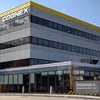IDC predicts double-digit growth for 3D printers
 Jennifer Stephens, senior learning specialist for manufacturing at Mount Wachusett Community College, removes an object from a 3D printer.
Jennifer Stephens, senior learning specialist for manufacturing at Mount Wachusett Community College, removes an object from a 3D printer.
Shipments of 3D printers in the U.S. grew by nearly 20 percent in 2015 and will continue to grow over the next four years, according to a recently published forecast from Framingham-based International Data Corporation.
The forecast, announced Monday in a press release from IDC, predicts that 3D printer shipments will experience a compound annual growth rate of 16 percent through 2020. This is largely due to the fact that people and companies are increasingly recognizing 3D printers as a way to save time and money in production and development, according to IDC.
Overall shipments of low-end 3D printers, which usually sell for under $1,000, are projected to grow at a compound annual growth rate of 12 percent by 2020. Almost all of these printers are FFF/FDM based, which are most commonly used for at-home printing.
While growth on the lower end of the market is expected to continue, its market share will shrink as the popularity of commercial 3D printers increases, IDC found. In 2015, FFF/FDM printers accounted for more than 75 percent of total shipments, and that market share is expected to shrink to less than 60 percent by 2020.
Shipments of professional 3D printers, which rely on a range of technologies for accuracy and durability, are expected to grow by 20 percent by 2020. Printers based on stereolithography alone -- a high-end printer -- are expected to grow from 11 percent of total U.S. shipments in 2015 to over 20 percent by 2020. Printer manufacturers are gearing up for this change by adopting new processes, Greene said. Shipments of very high end 3D printers are also expected to grow aggressively.












0 Comments